|
Report
from
North America
Rebound expected in moulding and trim markets
US demand for moulding and trim is expected to rebound
and grow by an average of 10% per year to 2014,
according to a Freedonia study released in February 2011.
Moulding and trim demand suffered in 2008 and 2009
when the US housing market went down. New home
construction usually accounts for about 40% of total
demand for moulding and trim. Much of the increase in
moulding and trim demand to 2014 will be from a
recovering housing market and from non-residential
building construction such as offices and commercial
buildings.
Freedonia forecasts that demand for moulding and trim
will be US$9.6 billion in 2014, up from US$6.3 billion in
2009. Some 41% of the market will be mouldings, 30%
stairwork and 29% in other products. Interior mouldings
account for the majority of the market. Wood will remain
the leading material used in moulding and trim, followed
by metal, plastic and wood-plastic composites. Freedonia
forecasts that by 2014 plastic will be the second most
common material after wood. Plastic and wood-plastic
composites will gain market share in exterior moulding
and trim products. The price of wood materials is expected
to grow at a slightly faster rate than plastic or metal.
US tropical timber imports
Last quarter sawn hardwood imports improve
The latest quarterly import data shows that the value of
tropical sawn hardwood imports was at its highest in the
last quarter of 2010 since the end of 2008. The US
imported US$60.8 million worth of sawn tropical
hardwood in the fourth quarter of 2010, up 24% from the
previous quarter. Ipe imports soared by 169% from the
third quarter of 2010. Imports of keruing, cedro and sapelli
also increased significantly from the previous quarter.
December 2010 imports of sawn tropical hardwood were
19,866 cu.m., which represents a drop of 9% from 21,765
cu.m in November 2010. Balsa was back at the top of the
imported species with 5,253 cu.m in December. Ipe
imports remained high at 2,920 cu.m, followed by acajou
d¡¯Afrique (2,054 cu.m) and sapelli (2,017 cu.m). Although
imports of most species declined from November 2010,
volumes increased for keruing, mahogany, cedro and
jatoba.
Most supplier countries shipped less sawn hardwood to the
US in December 2010, with the exception of Ecuador and
Malaysia who benefited from the growth in imports of
balsa and keruing.
Year-to-date, import volumes of tropical sawnwood
increased by 19% compared to December 2009. Among
the species that gained significantly in the period to
December 2010 are jatoba (+87% year-to-date), acajou
d¡¯Afrique (+64% year-to-date), red meranti (+56% yearto-
date), sapelli (+52% year-to-date) and keruing (+48%
year-to-date).

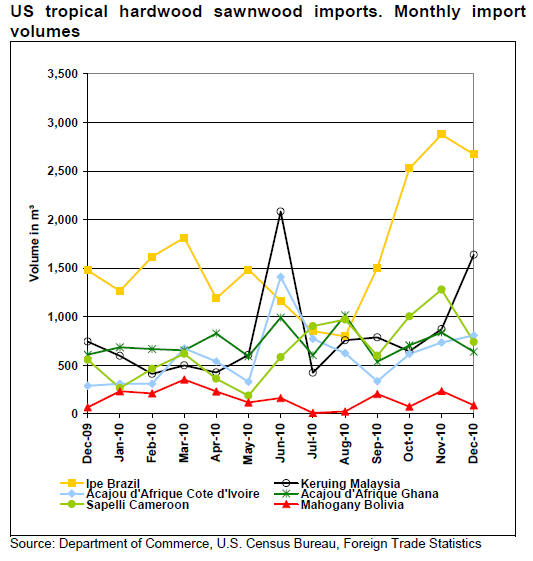
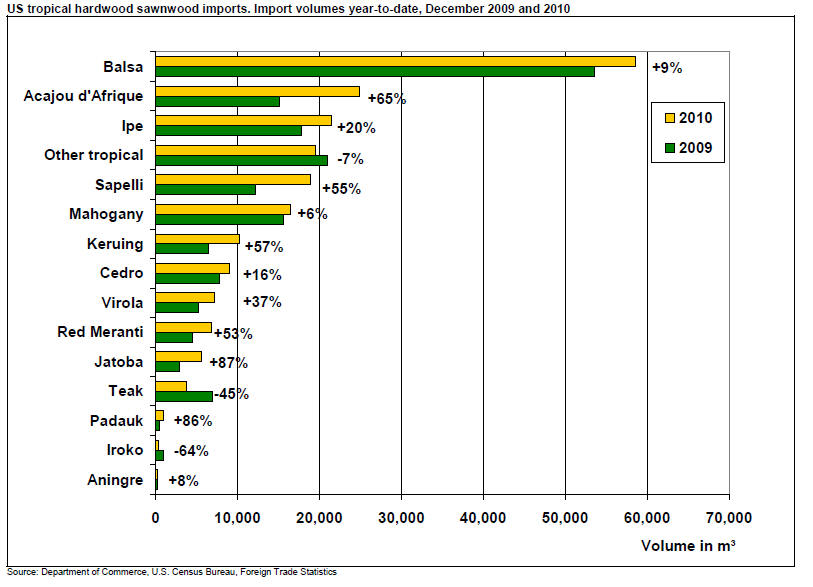
Malaysia and Indonesia increased hardwood plywood
exports to US in 2010
US imports of hardwood plywood declined in December
2010 to US$78.3 million, down 10% from November
2010. However, annual imports in 2010 were 26% above
2009 imports. When comparing 2010 with the previous
year, Malaysia saw the highest growth rate followed by
Indonesia, while imports from Brazil declined even further
from 2009. Imports from China accounted for 57% or
US$688 million of the total imports in 2010.
In December 2010, imports from China were US$54.5
million (+26% year-to-date) and from Indonesia US$4.7
million (+53% year-to-date). December imports from
Ecuador were US$2.3 million (+38% year-to-date), from
Malaysia US$1.3 million (+89% year-to-date), and from
Brazil US$0.7 million (-10% year-to-date).

Hardwood moulding imports on the mend
In 2010, US imports of hardwood mouldings increased
slightly to US$191.2 million, up 8% from 2009. December
2010 imports were worth US$17.8 million, a decrease of
3% from November 2010. Imports from Brazil continued
increasing and December saw imports of US$7.3 million
(+4% year-to-date) from Brazil. Imports from China were
US$4.9 million (+20% year-to-date). Malaysia supplied
US$1.6 million in December (+35% year-to-date) and
Indonesia US$653,000 (+30% year-to-date).
December 2010 imports of jatoba mouldings from Brazil
were US$3.2 million (-11% year-to-date), ipe mouldings
US$797,000 (+7% year-to-date), and cumaru mouldings
US$261,000 (+1% year-to-date). Supplies of cumaru
mouldings from Peru were US$337,000 in December
(+253% year-to-date). Mahogany moulding imports from
Peru were US$119,000 in December (-24% year-to-date).
Jatoba accounts for the majority of tropical hardwood
moulding imports, although in 2010 the value of imports
year-to-date was down by 6% compared to 2009. Imports
of cumaru mouldings were up by 42%, ipe moulding was
almost steady with 2% increase, while mahogany
moulding imports declined by 26%.
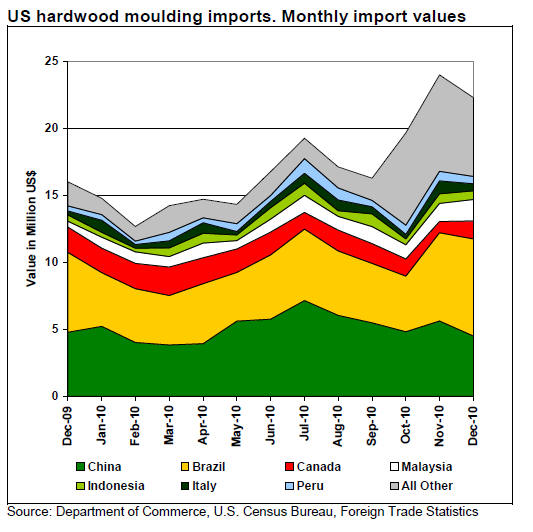
Tropical hardwood flooring imports improved
Even though hardwood flooring imports saw a slight
increase in December 2010, total imports in 2010 were
below 2009. In 2010, US hardwood flooring imports
totaled US$17.2 million, down 28% compared to the
previous year. However, flooring imports from tropical
suppliers improved during the same period.
In December, Canada was the only major supplier who
increased exports to the US from the previous month
(+63%). Hardwood flooring imports from China were
US$481,000, from Brazil US$388,000 and from Malaysia
US$325,000. On a year-to-date basis, imports from Brazil
increased by 10% from 2009, Malaysian exports increased
by 38%, Indonesian exports increased by 21%, while
Chinese exports to the US were down by 59% compared
to 2009.
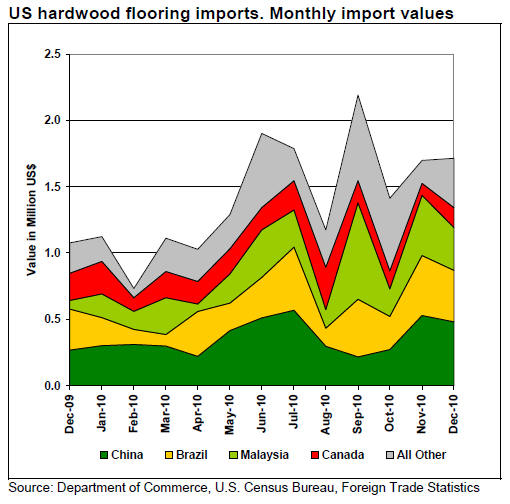
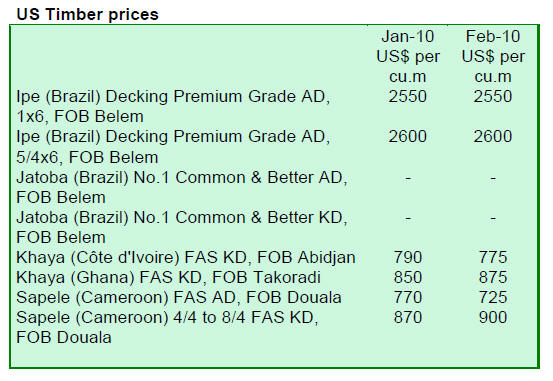
Related News:
|